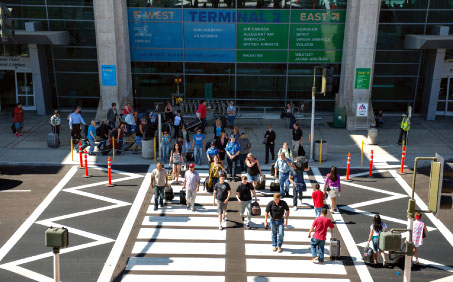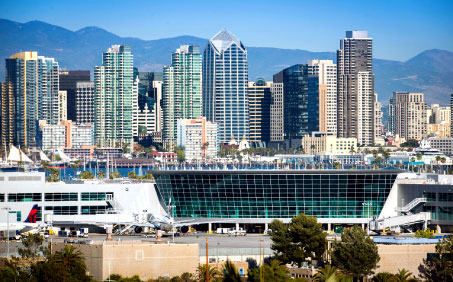
The design-build process used on The Green Build helped streamline the development timeline. “Having the architects and construction teams together in one space enabled us to solve problems even before putting a shovel in the ground and throughout the construction phase of the project,” commented Bowens.
The airport served 17.2 million passengers in 2012, and the latest available figures for August 2013 show a +2% increase year-on-year. The Green Build comprises several projects that provide a more pleasant travel experience for passengers. The first thing passengers notice is the dual-level roadway, which, for the first time, separates the airport’s arriving and departing passengers. Departing passengers can use enhanced curbside check-in, which allows them to check-in, print their boarding passes and drop off their bags. Once inside, passengers go directly to the new security checkpoint – five times larger than the original checkpoint, with twice the number of security lanes and more room for queuing.
The bright, spacious terminal is filled with natural light, and the 10 new gates feature modern seating with access to power outlets, USB ports and cupholders. A new concessions core – Sunset Cove – is a welcoming, bright area that offers exciting new concessions, as well as the Delta and United club lounges. Finally, more than $6 million (€4.5m) in art is integrated through The Green Build, providing colour, dynamism and an atmosphere unique to San Diego.
“The Green Build is ‘green’ for two reasons; one is for its sustainable elements – we’re hoping to achieve Leadership in Energy and Environmental Design (LEED) Gold certification from the US Green Building Council – and the other is for the ‘greenbacks’ it brings to the local community,” explained Bowens.

Bowens: “I think I’m most proud of the contributions this project has made to the community. More than 7,000 people were able to work on The Green Build, and millions of dollars went to small and local businesses. For the most part, the money spent on the project stayed in the region, and will have lasting effects.”
The Airport Authority Board was firmly committed to keeping much of the project’s money in San Diego, and as a result a full 89% of contracts went to local businesses. “That’s more than $415 million (€310m), $118 million (€88m) of which went to small businesses,” Bowens added. “A strong outreach campaign to small and local businesses, as well as an intentional effort to make packages smaller and therefore more attainable for small firms, helped us reach such incredible numbers. Additionally, The Green Build created more than 7,000 jobs over the course of the project, at a time when the region needed them the most.”
Impressively, the expansion was completed on schedule and $45 million under budget as a result of the economic environment, and prudent financial planning by the Airport Authority.
Sustainability and environmental sensitivity are hallmarks of The Green Build. The airport and its contractors made every effort to source construction materials regionally to minimise energy usage and the fuel required to deliver products. More than 54,000 tons of construction waste from the project was diverted from landfills, much of it recycled or reused on site. The project incorporates low-flow water fixtures, reflective roofs, the capability for photovoltaic (solar) panels, use of natural light and energy-efficient lighting, and native and drought-tolerant plants in the landscaping.
While San Diego International Airport may be finished with The Green Build, it certainly isn’t done maximising its 661 acres. It is working on the development of a consolidated rental car centre on the north side of the airfield. Landmark Aviation, the airport’s general aviation tenant, will break ground this autumn on a new GA terminal. And the airport is also in the midst of an Airport Development Plan, which looks at the future of Terminal 1 – already 50 years old – as well as the potential development of land on the southwest side of the airfield.







